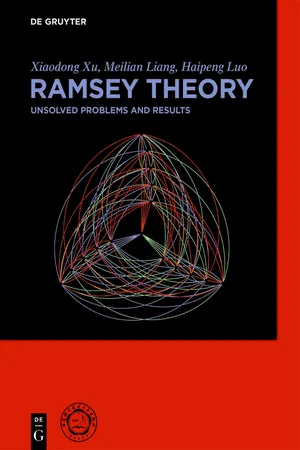
Ramsey Theory
Unsolved Problems and Results
- 190 pages
- English
- ePUB (mobile friendly)
- Available on iOS & Android
Ramsey Theory
Unsolved Problems and Results
About This Book
Key problems and conjectures have played an important role in promoting the development of Ramsey theory, a field where great progress has been made during the past two decades, with some old problems solved and many new problems proposed. The present book will be helpful to readers who wish to learn about interesting problems in Ramsey theory, to see how they are interconnected, and then to study them in depth. This book is the first problem book of such scope in Ramsey theory. Many unsolved problems, conjectures and related partial results in Ramsey theory are presented, in areas such as extremal graph theory, additive number theory, discrete geometry, functional analysis, algorithm design, and in other areas. Most presented problems are easy to understand, but they may be difficult to solve. They can be appreciated on many levels and by a wide readership, ranging from undergraduate students majoring in mathematics to research mathematicians. This collection is an essential reference for mathematicians working in combinatorics and number theory, as well as for computer scientists studying algorithms.
Contents
Some definitions and notations
Ramsey theory
Bi-color diagonal classical Ramsey numbers
Paley graphs and lower bounds for R(k, k)
Bi-color off-diagonal classical Ramsey numbers
Multicolor classical Ramsey numbers
Generalized Ramsey numbers
Folkman numbers
The Erd?s–Hajnal conjecture
Other Ramsey-type problems in graph theory
On van der Waerden numbers and Szemeredi's theorem
More problems of Ramsey type in additive number theory
Sidon–Ramsey numbers
Games in Ramsey theory
Local Ramsey theory
Set-coloring Ramsey theory
Other problems and conjectures
Frequently asked questions
Information
1Some definitions and notations
1.1Some definitions in graph theory
Table of contents
- Cover
- Title Page
- Copyright
- Preface
- Contents
- 1 Some definitions and notations
- 2 Ramsey theory
- 3 Bi-color diagonal classical Ramsey numbers
- 4 Paley graphs and lower bounds for R(k, k)
- 5 Bi-color off-diagonal classical Ramsey numbers
- 6 Multicolor classical Ramsey numbers
- 7 Generalized Ramsey numbers
- 8 Folkman numbers
- 9 The Erdős–Hajnal conjecture
- 10 Other Ramsey-type problems in graph theory
- 11 On van der Waerden numbers and Szemerédi’s theorem
- 12 More problems of Ramsey type in additive number theory
- 13 Sidon–Ramsey numbers
- 14 Games in Ramsey theory
- 15 Local Ramsey theory
- 16 Set-coloring Ramsey theory
- 17 Other problems and conjectures
- Epilogue
- Bibliography
- Index